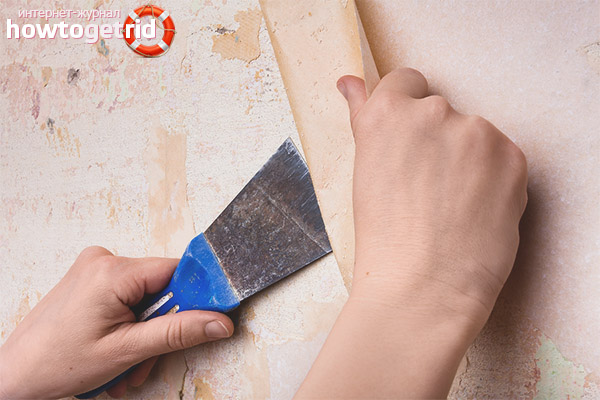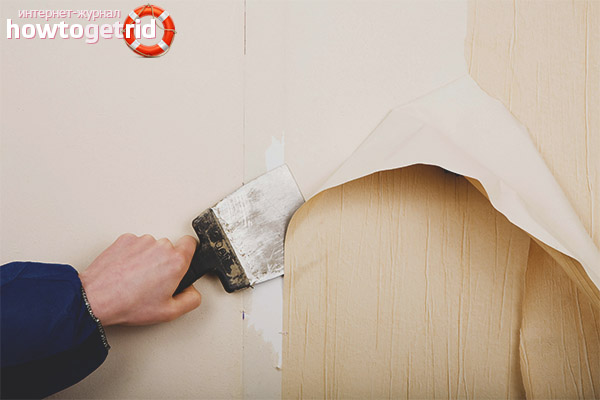The content of the article
When purchasing housing in the secondary market, the most incredible coloring of wallpapers is often inherited from the previous owners. And even if the type of wallpaper indicates a good taste, the new owners want to redo everything to fit their individual preferences.
Before you start wallpapering, to achieve perfect results, you need to prepare the walls, get rid of all obsolete fragments. Removing previously glued canvases, one can meet a number of difficulties, to overcome which an individual approach is necessary.
New wallpapers are not only a tribute to fashion. This is a change in life, an attempt to erase from memory some boring, and sometimes not pleasant events. The new color scheme can help cope even with depression!
The importance of total removal of old wallpaper
If you don’t completely remove the wallpaper from the walls, in the future you can create additional problems for yourself:
- Hazardous microorganisms, pathogenic bacteria, and mold can lead active life under layers of old, unrecommitted sites. They can cause serious harm to human health.
- Old wallpapers will not allow you to create the perfect surface, give a visually unaesthetic look. Spoil the overall impression of the repair as a whole.
- It is likely that the remnants of old wallpaper will not allow even adhesion to the wall of new ones. They can lead to bloating of areas of fresh stickers, as well as peeling of old, and then again, glued.
Despite the fact that the procedure is laborious and requires time and effort, it must be approached seriously and responsibly. Qualitatively prepared walls for pasting are the guarantee that this will avoid serious problems in the future.
What do you need to prepare?
Supporting tools to remove the old wallpaper layer:
- Spatulas with pointed edges (of different widths).
- Dishes with a polymer sponge or a special container with a paint roller.
- Roller with needle texture (wallpaper "tiger") for perforation.
- Polyethylene film.
- Remover for removing the old layer, warm water.
- Joiner's knife.
- Masking tape.
- A mop with a steamer or an iron with a cotton cloth.
Stages of preparation for the removal of wallpaper
The amount of time taken to remove the wallpaper directly depends on the type and adhesive material that was used for application on walls and paintings. Having determined the level of complexity, they begin to prepare the field of activity:
- To protect the floor from construction debris, the surface is covered with plastic wrap, which is fixed with tape to the surface. It is also necessary to prevent dust and dirt from entering the furniture.
- De-energize the wiring, prevent a short circuit due to the ingress of water into sockets and open, bare areas.
- The switches and sockets are sealed.
- A household detergent is added to the water. Such a talker is more effective for soaking old glue and wallpaper, regardless of their type.
The nuances of removing various types of wallpaper
Vinyl - A durable vinyl film, arranged with a paper base. Their removal is not particularly difficult. On the entire surface of the wall, with the help of a gear roller or a construction knife, scratches are applied. This simple procedure can greatly simplify the task.
Before removing the vinyl wallpaper, the surface is wetted with water and allowed to absorb moisture.Having got under a vinyl film, moisture partially dissolves the glue, and this greatly simplifies the process: it allows you to pull the edge with a knife and pull off the edge of the wallpaper with a layer and remove it with a knife. The integrity of the waste material is maintained due to polyvinyl chloride, which has strong properties and provides the removal of wallpaper with whole tapes. The final step will be the removal of small pieces of paper from the wall by means of a narrow spatula and water.
Non-woven and washable wallpapers. A characteristic feature of them is the waterproof layer. To make water or liquid available for wallpaper removal, the integrity of the surface must be compromised. For this, cuts and holes are appropriate. Removal is complicated by the presence of synthetic fiber in the composition, which gives strength to the material. Moisture trapped through the notch helps swell and moisturize the glue. Having sustained a small interval of time, it will be possible to easily remove the old wallpaper.
Paper tapes are removed in several ways:
- Before removing from the walls, cuts are made on the canvas. Prepare a solution of water with vinegar or fabric softener. Wet the walls with a roller and a mixture, allow to soak (15-20 minutes). After swelling the paper, using a spatula, the wallpaper is removed in large pieces, and re-wetting will eliminate small fragments.
- Use special tools, the purpose of which is quick and effective removal of paper tapes. They are characterized by the ability to penetrate deeply into the thickness of a sheet of paper, and accelerate the process of getting rid of old wallpapers. The chemicals that make up the liquid are designed so that they do not pose a risk to human health and can be used without restrictions. To use, mix warm water with a chemical composition. The resulting mixture of liquids is applied to the wallpaper. The main action of the substance is aimed at destroying the structure of the adhesive, the integrity of the wallpaper is not violated. Having sustained exposure time, wallpapers are easily removed with a spatula. A little trick is to add wallpaper glue to the product. Soaking a paper layer with such a composition allows you to remove layers without small debris.
- The use of steam generating devices, household steamers, greatly simplifies the task. By thermal action on the old glue they achieve its swelling and further removal without any special difficulties. This is a universal method applicable for all types of wallpapers.
- PVA glue - a win-win option for bonding various types of surfaces. Wallpapering with its application is particularly durable. There are also adhesives that are not able to dissolve in water. The application of the above methods is not applicable to such substances. To remove wallpaper resort to mechanical methods of exposure. Manual scraping is a complex and time-consuming process. To facilitate the work, you can additionally sharpen the spatula. They also resort to more serious methods of exposure. The task can be simplified if the farm has a grinder or a drill with a “metal brush” nozzle. Without such devices, sandpaper with large abrasiveness will help to cope with difficulties.
The liquid wallpaper - have a liquid structure and consist of water-soluble glue, cellulose and cotton. To remove such a composition, it is enough to apply warm water. Having wetted a surface it is possible to remove easily with the pallet. The uniqueness of the wallpaper is that if desired, they can be reused.
To this day, there are walls with historical, Soviet-era wallpaper. They are unique and highly durable. Pasting by them was carried out by means of strong adhesives (CMC, carpentry glue, bustilate). An amazing fastening ability was possessed by a paste cooked in the kitchen from flour. Also, for reliability, an interlayer newspaper layer was used.Removing this decor turns into a real torment, as the material lends itself to various influences tightly, centimeter by centimeter. Fortunately, such cases are already rare.
Features of removing wallpaper from drywall
Having removed the wallpaper from any wall surface, it is important to understand that this does not always solve the problem of evenness of the surface. Perhaps this is just an important intermediate step and additional methods of leveling the walls are required.
Adhering to certain rules, having free time, desire and patience - the process of removing wallpapers will not present you much difficulty. It's always nice to do something for yourself with your own hands. But you can also resort to the help of specialists whose experience will speed up the process and save you from unnecessary trouble.
Video: how to shoot wallpapers correctly and quickly











Submit